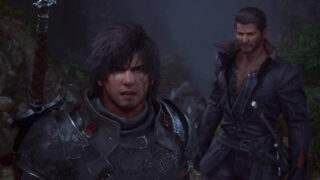Earlier this month, Gematsu sat down with Final Fantasy XVI producer Naoki Yoshida, director Hiroshi Takai, combat lead Ryota Suzuki, and localization director Michael-Christopher Koji Fox as part of a roundtable interview to discuss the next mainline Final Fantasy title during its global media tour.
Get the full interview below, with supporting questions by Scott Clay of RPG Fan and Matthew Byrd of Den of Geek.
RPG Fan (Scott Clay): The choice for Ifrit for Clive—was that chosen from the start? Did you build the game around that, or was it the story and world building that led you to choose Ifrit as Clive? Or Clive as Ifrit?
Naoki Yoshida, Producer: “We’re not going to say that Clive equals Ifrit yet, we’re going to keep that a little bit in a gray area, but when designing the game, that idea that Ifrit was going to be a main core component of the game was something that we decided on very, very early on.
“The reason we decided to go with Ifrit as the core component of our game, rather than any of the other summons that appeared in the Final Fantasy series, is because Ifrit is usually one of the first summons that you encounter. He appears first, you defeat him first, you get him first—and then he’s the first summon you stop using because he’s the weakest and you start using the more powerful ones.
“But from a design perspective, the design for Ifrit is really, really cool. Also the element is fire, which is very easy to understand. And if you’ve played Final Fantasy, even if you didn’t make it to the end of the game, most players are all going to know Ifrit. And so it’s one of the most recognizable summons in the series.”
Den of Geek (Matthew Byrd): Final Fantasy XVI is obviously different in a lot of ways from other recent Final Fantasy titles, but when you were talking about Cid, you used the word ‘constants.’ Were there a series of ‘constants’ at the start of development that the team said, ‘no matter what we do, these have to be in the game’?
Yoshida: “Chocobos, Moogles… and then some of the ships, like the Enterprise. We haven’t said anything about the Enterprise, but you know, you can assume that maybe we’ll have an Enterprise. And then of course the magic names. Also things like weapon names, monsters like Marlboros, Coeurls, and Behemoth.
“We’ve seen that Final Fantasy over the past 10 to 15 years has shifted from older fantasy into more a science-fiction type of game—a lot of the recent games have been playing with that—but for us here that all grew up with Final Fantasy, from I up until about VI, we played those in real-time. And they left a lasting impression on us. Those were more of that classic fantasy, that type of gothic fantasy. And thinking about what type of fantasy we wanted to create for this new game, we wanted to go back to the roots of the series—to bring some of that gothic fantasy from earlier Final Fantasy titles into this one.
“And then one other thing is bringing the focus back on the crystals as well, something that you saw earlier in the series and we focused a lot of games on. So we’re putting that main influence on the mother crystals here in Final Fantasy XVI.”
Hiroshi Takai, Director: “Another thing you see a lot of in Final Fantasy games is, there is always some kind of civilization that existed in the past, and you see the remnants of that civilization in the modern world. We have that as well in Final Fantasy XVI. There’s a civilization called The Fallen, and you see the remnants of that Fallen civilization all throughout the land, and you learn a little more about that civilization as you explore in the game.”
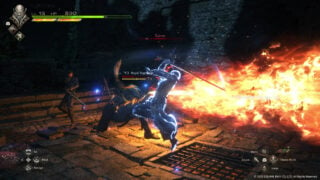
Gematsu (Sal Romano): For Final Fantasy XVI, you were given this major challenge of leading the creation of an all-new battle system. And coming from a background of Devil May Cry, there will obviously be a lot of comparisons to that. So how, when taking on this challenge, did you figure out what to bring over from past works, what to innovate on, and how to bring it all together to make it feel like a Final Fantasy combat system, while still being brand-new?
Ryota Suzuki, Combat Lead: “Because one of the main themes of this game is the Eikons, we wanted not only the story to focus on Eikons, but for battle to have that flavor as well. And so while Clive is a master of the sword, he also learns these new Eikonic abilities as he goes through his journey and those become his own actions. But making those actions feel like they both tie into the story as well into battle—such as how they feel, how they look, how they play, and how they pertain to where he is in the story—was the main challenge.
“The other thing is that this is the first full action game in the Final Fantasy series, and it’s going to be, for some of our series users, the first action game that they ever play, so we wanted to make sure that it is accessible to those users. But at the same time, we want it to also be something that’s going to excite the heavy action users—those users that like the Devil May Cry and those type of games. Something that has a very low floor, but also a very high ceiling, and cover all of the bases, while still feeling really, really good. What I learned at Capcom, spending all my time there working on action games, the 2D fighting games, games like Monster Hunter and Devil May Cry—taking all of the things that I learned from creating those type of action games, I was able to take the best parts of those and use them to create the battle system in Final Fantasy XVI.
“And for those players that aren’t familiar with action games, we wanted to create something that had the feel of an action game, but also have this ease of use and ease of accessibility without there being too high a high hurdle for those players. To sum it up, we didn’t want it to be difficult to understand, but also wanted to appeal to the heavy action users.”
RPGFan: The summons in Final Fantasy are super iconic, but sometimes you guys like to throw curveballs when you replace them. For example, Quetzalcoatl replaced Ramuh in Final Fantasy VIII, and Final Fantasy XII‘s Espers are totally different. Were there any Espers or Eikons that you guys wanted to put into Final Fantasy XVI that they may have gotten cut, or that you really, really loved, but said, ‘we can’t make that work,’ or something like that? You guys went super safe with the iconic summons, but I’m curious if there’s any new ones that you may have put in too, like you did in Final Fantasy XIV.
Yoshida: “I’m trying to navigate this question without giving you any spoilers, which is a little bit difficult… So our original concept was, similarly to the battle system, we wanted to make something that’s accessible to a lot of different players. And when looking back on all the games in the series, we wanted to choose summons that people had played, maybe from this game or that game or this game—ones that they all know. And then taking those, like you said, iconic summons, and then recreating them from the pixel art into something that is made with the cutting-edge technology that looks very, very real, whether it be design or size.
“That being said, it’s really hard to say, but there are some battles with some enemies that are very large, and maybe things that players will not have seen before, or may have not see before in the series. It’s really hard to say without spoiling anything.”
Takai: “In that sense, we wanted to bring out these Eikons that players already knew, and not really create new ones specifically for Final Fantasy XVI. That being said, you mentioned before, were there any that we had an idea we were going to put in, but maybe were cut during the planning process. It turns out there was one from a past Final Fantasy that we were thinking of using, but ended up not using.”
Yoshida: “Do you want to say the name?”
Takai: “I don’t want to say it.”
Yoshida: “We’ve spent so much time and effort and cost in creating all of this stuff. There was a point in time where we thought we had too much content, and it was getting to the point where it’s like, ‘okay, we have this many Eikons, maybe we should actually cut one, because it’s getting a little bit too costly.’ But then, when we ran the numbers, it turned out it would cost more to remove it from the game than leave it in, and so we ended up leaving it in.”
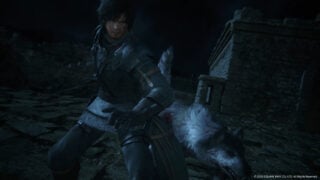
Den of Geek: I can only imagine how difficult it was to work on two Final Fantasy titles at the same time—Final Fantasy XIV and Final Fantasy XVI. Were there any benefits to that process? Were there ways that the work on one game improved the work on the other, or opened up new ideas?
Yoshida: “I think that we’ve lost so much more than we’ve gained. Like time to sleep, my youth… the pressure has also been heavy. This is just one of those situations where there’s a lot of things we learn because we’re on both… but one thing that we really have learned due to our time on Final Fantasy XIV is about our communication with the community and and being honest with them. That’s something that I wanted to maintain while on Final Fantasy XVI as well.
“For example, when promoting the game, a lot of recent AAA games have been going the open-world route, and you see a lot of games like Hogwarts Legacy doing that. And when promoting it, it would have been very easy for us to scurry around that and promote our game as the same type of thing rather than telling the truth. So we thought let’s just get out ahead of it, let’s tell them that we’re not open-world, but then again be truthful and tell them why we didn’t go with the open-world. We didn’t go that route because we wanted this game that spanned many different nations and wanted to tell a detailed story that would not have been possible if we had an open-world situation. So basically we took this thing that currently can appear to be a negative in a sense, got out of in front of it and talked about it, and let the fans know exactly what we’re doing instead of trying to cover it up. It would have been easy to not mention it at all and get people thinking it’s an open-world, but that would end up disappointing them at the end. So instead, we were truthful, and let people understand what we were thinking and why we did this.”
Gematsu: So much of what we’ve seen so far of Final Fantasy XVI has been very dark in tone. Will there be any lighter elements to the game, either story-wise or gameplay-wise? Gameplay-wise, can we expect things like, minigames like fishing or blitzball? OK, obviously not blitzball, but the Final Fantasy XVI equivalent of blitzball—Cliveball.
Yoshida: “We have some very dark themes that the story revolves around. We have countries at war—we can’t really have some blitzball matches going on when people are killing each other. And then when you have this hero who’s talking about and driven by revenge be like, ‘I’m gonna go out and fish!’ In that sense, there aren’t those types of light things that are going to detract from the story that we’re trying to tell.
“However, if you remember from the presentation, we talked about Cid, and Cid has this organization. Their headquarters is this place called the Hideaway. And once Clive meets up with Cid and is able to join that organization, then you have this kind of hub from where all this side content that’s separate from the main story starts. And so we have things like quests where you can learn about the people in the Hideaway, or quests where you can learn about the people in the world… quests where you can help upgrade Clive, like earning more inventory slots and things like that. There are other type of activities as well, such as the Hunt Board, where you will see the billets. It’ll talk about a notorious monster roaming the land, and your task is to try to find and defeat this monster for fame.
“I’m going to have Takai-san talk a little bit more about it, but there’s even more types of side content as well. Things that are not even related to the story, like an arcade mode where you earn high scores, which has a leaderboard, and things like that. We’ll have him talk about that more later. But one thing we want you to understand is that the media tour and this demo that we gave you takes out parts of the game focused on the combat. And so because of that, it’s going to be very violent, it’s going to be very dark, and it’s going to be very action oriented, and not really touch upon the more lighter aspects of the game. There are lighter aspects, there are more emotional aspects of the game. You have themes such as brotherly love, and the love of a nation, love of others—these friendships, these bonds, and things that you’ve come to expect from the Final Fantasy series. Those type of themes will also be covered in Final Fantasy XVI as well. And there are portions that are going to get deeply emotional. And there are also lighter parts, because when you talk about a story that’s dark, it’s always about finding hope in that darkness. And there’s a lot of hope in this game as well.”
Takai: “And like we mentioned before, while we don’t have minigames such as fishing or blitzfall, we do have a lot of content that focuses on our action and the battle system. We have lots of different separate types of challenging content. For example, there is a special mode, a battle mode, in which you are locked to a certain ability of a single Eikon, and you must clear a bunch of different content in that to earn special items. There’s also New Game Plus, which carries over your play data, and you’re able to play the game again. And you can do that in story-focused mode or action-focused mode, but for New Game Plus we also have a third mode that we introduced called the Final Fantasy mode, which not only is more difficult, but also changes enemy placement and the enemies that you fight, so it’s a completely different experience. It isn’t just a harder version, it’s a completely different type of experience.
“Another thing that’s available in the Hideaway, which was mentioned before, is that you unlock a side game where you can replay stages, but this time to earn score. And we call that our arcade mode. And if you play this arcade mode in New Game Plus, you have the ability to upload your scores to the Global Leaderboard and see how your scores stack up against other players around the world. So all of that combined outside of the main story, there’s a lot of different content to keep the player engaged beyond just the main story.”
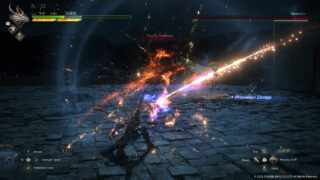
RPGFan: Were there any characters you and the staff are largely fond of, writing-wise or design-wise? Who was that?
Yoshida: “It’s another one of those difficult questions that’s hard to answer without giving too many spoilers… My favorite character is a character that we haven’t introduced yet. So I can’t tell you too much about them, but I can tell you that it is an older character in the game, not very young. We talked before about how the game has this very dark feel, but this character is very, very lovable—kind of comedic in a sense—and that’s why I love him, because he brings that light to the darkness. So we have this very dark game, but when that character is in the room, he kind of lights up the room and makes everything look not so dark. So we focus on the dark… but it’s not all dark! And there’s one scene where that character comes out, and that’s a scene where I will always cry, even when I’m doing my checks. It’s a very, very good scene.”
Suzuki: “Clive. (Laughs.) I’ve been polishing Clive for the past three years. Polishing and polishing and polishing, that’s all I’ve done. (Laughs.)”
Takai: “That’s probably the hardest question that I’ve gotten this whole media tour. If you made me choose right now, I would probably choose Cid. We mentioned that Cid turns into sort of a father figure for Clive. You have this Clive who’s basically focused on revenge, and revenge only, and then Cid comes in, and not being condescending or anything, just kind of opens up Clive’s eyes to the fact that there’s another world out there. It’s not all about what you see. What you see is important, yes, but take a look at what else is going on around you. And he’s able to convince Clive to come out of his shell.”
Den of Geek: You mentioned different eras of Final Fantasy—fantasy, sci-fi, things like that. Is it your hope that Final Fantasy XVI could be a new path forward for the franchise? Or do you hope that every Final Fantasy game can always be different and can always try new things?
Yoshida: “I think that moving forward we don’t want to push the Final Fantasy series in one direction. I think that one thing I remember was that when I first joined Final Fantasy XIV and took over, the director Kitase-san told me that Final Fantasy is what the creators at that time think Final Fantasy should be, and that’s what you should do when creating this game. And I really took that to heart, and so I want that to be the same thing that creators moving forward can do—what they think is the best thing they can make. Because that’s what we’re doing. What we thought would be the best Final Fantasy is what we’re creating.”
“One thing that I’ve noticed working with the series for so long and speaking to fans from around the world is that a lot of people started getting that Final Fantasy is this type of series I’m looking at as a series that, for example, has become very niche in the sense that the Final Fantasy series is about JRPGs, or anime characters, or about teens running off saving the world, and that’s what all the games are going to be like. And then people were kind of getting locked into this image of what they believed Final Fantasy was. But for me, as someone who is going to be 50 years old this year, I know that the world isn’t all sunshine and rainbows and stuff, I know that it can be tough sometimes, as well as have hope in it sometimes. And so I wanted to create something that again, felt real, but not just for my generation, but for the younger generation as well, and show that the potential of the Final Fantasy series. As for why we went dark fantasy, well, that’s just because we all love dark fantasy.
“I talked about how the player base gets locked in that vision of what Final Fantasy is, but it’s the same on the development side as well. People in Square Enix think that when making Final Fantasy we have to do it this way because this is the way they did in the past. What we wanted to do and what we wanted to show the next generation of developers and the younger developers with Final Fantasy XVI is that you don’t have to get locked in that. You can do whatever you want and anything is possible with the Final Fantasy series.”
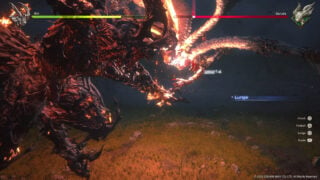
Gematsu: One of the things you guys stressed with the Eikon battles is that each one is unique. We got a small taste of that in the demo, which played pretty similarly to how Clive normally plays. I’m curious, by ‘every battle is unique,’ what do you mean in that sense? Is each battle going to play as a different genre? I noticed in the footage you guys showed there was something that looked sort of like a shoot ’em up. What are you guys doing to make each battle unique and how are you doing it without making everything feel too gimmicky? Not to say the battle we played was gimmicky, but for other battles.
Suzuki: “Basically, when deciding on what to do with each of these battles, we kind of knew where the beats were going to be, and when Clive would encounter each of these Eikons. So each battle was given a theme. For example, for Ifrit versus Garuda, that theme was to do something that felt like a pro wrestling match—something that was like tokusatsu, like an Evangelion or Ultraman type of battle—and that was the main theme, something that had this really weighty feel to it like you’re controlling these giant kaiju or mechs.
“But the others also got their own unique theme. For example you saw a battle that looked like a shoot ’em up—so we have one battle that we wanted to focus on making kind of like a shoot ’em up. And this is completely different from the Clive-type of actions because it’s now a shoot ’em up type of battle. Also we have another one that was a very dynamic, speedy type of battle where you have the Eikon fighting something much larger than itself, and you’re running around and using that character as the entire stage.
“But when the player is controlling Clive, you have this sense of having full control over him. But when creating these dynamic battles we wanted to move the focus from Clive and focus it on the Eikons because that was more important in those scenes. And so creating these battles that felt separate from the actual Clive battles, fresh from those Clive battles, and focusing on how each Eikon interacts with the Eikons and the special type of moves that they’re going to only do in that type of situation.”
Takai: “And again with these Eikon versus Eikcon battles, unlike a lot of the fights in the field which could be random or just there, these all are tied in directly with the storyline. So there has to be a reason why these two are fighting and what the two Eikons are feeling—what is their story, why are they there fighting, why are they in that location, what are the reasons behind this? And that all kind of ties into the fight and how we’re going to design the battle.”
“So it all comes down to the situation—what fits the story. For example, so when we say we have a shoot ’em up battle, it’s not just us throwing in a random shoot ’em up because we want to make it a gimmick, it’s because it fits that situation. For example, the Ifrit versus Garuda fight that you played—the feel that we gave it, that kind of weighty feel, and the kind of all-out brawl is because story-wise, the two have kind of lost themselves, and so neither of them have control and you get this battle that just feels really weighty and like they’re just going all out on each other because that fits what’s going on in the story. And because of that it’s hard to talk about more of the battles that we have in the future because, again, it ties so directly to the story that telling you about these we have these type of battles as well is going to kind of spoil the story.
“But like I said it’s all about that situation. Making these all one-offs helps us tie the situation or tie the battle better to the story, but because we’re doing that, development-wise, it’s a lot of cost. Because we’re creating something that fits only the situation at hand, and then we can never use it again in the rest of the game. So we’ve spent all of this cost and all of this effort creating one thing that the player is going to play once—and never use that ever again. So from a development perspective it’s like, ‘why are we doing something so crazy?'”
Yoshida: “So do you guys all play classic games like on the regular Nintendo Entertainment System? (Everyone nods.) So that’s kind of what we were aiming for, like the old NES games where all you have one game—it’s one concept and that game is focused on that one concept. So for example, if you have a driving game, all you do in that game is drive. You may have different courses, but it’s a driving game.
“So for Final Fantasy XVI, we looked at our battles as kind of like mini NES games. ‘We have this battle here, we’re an action RPG, but why not have a driving game in our action RPG?’ And then ‘maybe for this battle here, let’s have it be like a 3D brawler.’ And then of course there’s always the question of, ‘OK, we this one battle takes place on the ground, so what if we had this battle take place in the air or in a place with zero gravity?’
“And so each boss battle is something where the experience changes. It’s going to be different every time and the players are not going to know what to expect because it’s going to be different from the previous boss battle. We’re creating something that’s going to feel unique every single time. And something that’s going to make the players say these guys are flipping crazy to create something like this, where each one is separate. So we have all these different types of experiences and again we can’t talk about them here, but I really think there’s something that the players can really look forward to and are really going to be excited about.
“We want to show you all of them now, but they’re all story spoilers, so we can’t!”
Everyone: Thank you so much for your time!
